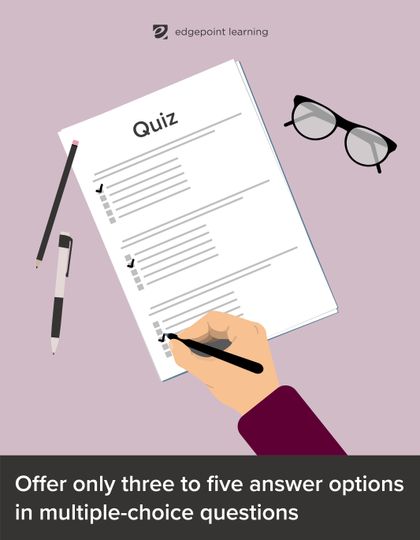How to Write Quiz Questions for Training: 14 Tips
Corey Bleich
🍿 7 min. read
Many of us remember the nerve-wracking, pencil-tapping anguish of taking the SATs or the nail-biting wait for the results of a learner’s permit test. The idea of taking a quiz or test as an adult may have many of us breaking out in a cold sweat, but it doesn't have to be that way. If you are in charge of developing quizzes for employee training programs, writing great questions yields more accurate results, greater compliance tracking, and better knowledge retention among learners. These are our tips on how to write quiz questions.
🔍 What you’ll find in this post
Who needs a quiz anyway?
If you thought quizzes were in the rearview mirror of high school or your undergraduate career, think again. So who needs a quiz?
- Employees who may be called upon to display their understanding of key topics for compliance and safety reasons
- People in the process of gaining certifications or licenses
- Professionals upskilling in their field who need additional support to retain information
When building eLearning courses, quiz questions are a quick and easy way to gauge what a person knows — and what they still need to learn.
Why good questions matter
You may be designing quiz questions for adults, but nothing elicits eyerolls faster than irrelevant, repetitive quiz questions riddled with typos or spelling errors. Adult learners can be some of the most enthusiastic — or the most judgmental — when it comes to a poorly designed quiz.
The bottom line is this: if you are really interested in seeing what your employees know, understand, and can do, you’ll need to ask the questions that give you the clearest insight into where they are in their learning journey. The best questions build and reinforce their understanding of key concepts, and test their deeper critical thinking skills.
How to write quiz questions
Ready to get started? Here’s how to write quiz questions for employee training programs.
1. Define your learning objectives
Before writing quiz questions, clearly outline the learning objectives you want to achieve. These learning objectives are a roadmap for creating the content of your eLearning course, ensuring that you teach and then test their understanding on those objectives you lay out. This helps you create focused and relevant questions that test learners' understanding of something specific.
Developing the right learning objectives is an art in and of itself, so we’ve created a guide to get started with Carrie Lewis Miller, instructional designer with IT Solutions at Minnesota State University, Mankato, and Quincy Conley, the Director of the Teaching & Learning Center at A.T. Still University.
👉Learn more: Read our full eBook on how to define your learning objectives here
2. Vary question types
If your quiz takers are habitually picking “C,” it’s time to shake things up. Most people can learn a few strategies to accurately guess in a multiple-choice or multiple-correct quiz, but this yields no meaningful results. Randomizing answer options in these types of quiz questions is an easy way to focus learners on selecting the best answers and not just their quiz taking strategy.
Another way to prevent guessing and actually see what learners know is to use a mix of question types that may include:
- True or false
- Fill-in-the-blank
- If-then scenarios
- Matching
- Sorting into categories
- Ordering
This keeps the quiz engaging and tests different aspects of the learners' knowledge. Writing different types of eLearning quiz questions doesn’t take much longer, and it produces results that more accurately reflect what learners know.
3. Avoid jargon, slang, and (too much) humor
One of the most important things to know about how to write quiz questions is that the words and tone matter.
Unless you are testing a person’s understanding of actual jargon (words that are specific to a field or process), keep the insider chatter to a minimum.
You don’t want quiz takers to be so confused by the language that they don’t understand the question. This doesn’t mean you need to “dumb it down,” but it does mean that quizzes should not be checking if learners can understand the context of the question instead of uncovering if they actually know the answer.
Same goes for slang and too much timely humor. If you are in an industry that is constantly changing, thus necessitating frequent quiz updates, these might be more appropriate. But skip it in industries that are less changeable.
4. Limit the number of choices
As in life, sometimes people get paralyzed by too many choices on a quiz. If you decide to use multiple-choice or multiple-correct questions, offer only three to five answer options. Having too many choices can overwhelm learners and make the quiz unnecessarily difficult.

5. Keep your questions and answers concise
When writing quiz questions, focus on wording your questions and answers concisely. Too much wording clutters the screen and quickly becomes overwhelming for learners. Scrolling through questions can make it easy to lose the point. And, for those using assistive listening devices, each answer can be a chore to listen through.
This is also important to make development easier. Too many choices, long answers, and long paragraphs of questions can all break your course templates and require re-work for design.
6. Make all choices plausible
Again, just like life, all choices on a multiple-choice or multiple-correct quiz should be plausible. This forces learners to think critically and truly understand the material.
Your quiz is not meant to trick the quiz taker. You’re not trying to trip them up by changing one single word or mixing correct parts of an answer with an incorrect choice. But you do want to write challenging questions that make people think about their answer.
7. Balance the level of difficulty
Create a mix of easy, moderate, and difficult questions targeted to learners of varying skill levels and to maintain engagement.
One way to do this is by incorporating adaptive quizzes into your design. AI programs can automatically order quiz questions by difficulty. They can adapt which question they offer as the quiz taker progresses. If someone is whipping through and getting every answer correct, the program can up the difficulty accordingly.
Alternatively, many development tools will allow you to set the weight of questions in the final results. Easy questions get a smaller score when answered correctly, harder questions are weighted to earn more points.
👉 Learn more: Find out how to use AI tools to create your eLearning materials
8. Avoid negative phrasing
If you’ve ever been annoyed by a double negative that’s actually not not positive (like that right there), make sure to avoid it in your quiz design. This can be seen as sneaky and is certain to set up the wrong mood for learning.
This sort of quiz question is also a definite holdover from your high school days. It tests if the quiz taker is paying attention, not if they know the material. Do everyone a favor and assume your quiz takers are attentive.
9. Test application, not just recall
Good test takers know strategies that can improve their chances of getting the correct answer — even if they don’t know it. We all know that one person who gets 100% on a quiz testing “How Pittsburgh Are You” when the whole office knows they are native Californians. This is all about test-taking strategies.
Prevent this by writing questions that test learners' ability to apply concepts and problem-solve, rather than just memorizing facts (or using test-taking strategies to get the answer).
10. Distractor quality matters
Distractors are incorrect answers designed to throw quiz takers off track and make them pay attention to all choices. They could be mistaken for the correct answer by someone who does not fully understand the material.
These are difficult to write without seeming condescending or foolish. Take the time to write high-quality distractors that are not insulting or overly ridiculous, but rather dive into the nuance of your employee training topic.
11. Use real-world scenarios
Real-world scenarios are the quiz-taking equivalent of on-the-job training. These can be created from actual events that have occurred in your industry, which makes them more relevant. Placing your user in the driver’s seat, and making them think through how to handle a situation is a great way to ensure they’re engaged.
👉Learn more: Discover how to write excellent scenario-based training
12. Randomize question order
When learners have the option of retaking a quiz for a higher score, go ahead and randomize the question and/or answer order during their next pass. This reduces the risk of learners memorizing the order of questions and answers.
And yes, adults are prime examples of people who do this. It’s a time-saving trick that is ultimately unhelpful if you want them to actually know what you're quizzing on.
13. Proofread and review
If you have ever witnessed the bloodbath that ensues online when someone makes a simple grammatical or spelling error in a meme, you’ll go through your quiz with a fine-toothed comb to catch all gaffes before you go live.
Don’t forget to check the clarity, accuracy, and relevance of all your info, too. The wrong spelling or word can signal an incorrect answer for testers, even though you’ve marked it correct. And if it’s not relevant to those original learning objectives you set up at the beginning, the best case is your learners will be annoyed with you, and worst, they’ll focus on retaining insignificant information.
14. Solicit feedback
It’s normal if you don't get writing a quiz right the first time. Ask colleagues or subject matter experts to review your quiz questions and provide feedback on their clarity, difficulty, and effectiveness in testing the learning objectives.
15. Analyze and iterate
Inevitably, some of your quizzes themselves will fail. Questions will be confusing, or they won't match learning objectives closely enough. After the quiz has been taken by a large pool of employees, analyze the results to identify areas where learners struggled or excelled, and use this information to refine your questions and improve future quizzes.
TL;DR: Creating a good quiz is tough
Knowing how to write questions for employee training is challenging. At EdgePoint, our team of instructional designers can guide you through the process or create great quizzes based on your learning materials. Whether you’re trying to update a few modules or create a learning plan from the ground up, we’re here to help.
We know how to write quiz questions. Get in touch today to find support!

